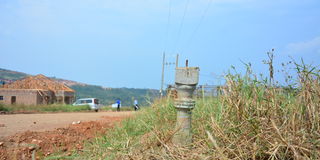What if building is key to the future?

Ripple effect. Some financial models have shown that investing in the housing sector leads to backward linkages to agriculture.
PHOTO/Lasha Senashvili
.
What you need to know:
The government has tried many approaches over time to modernise agriculture, with little success. What if, after 35 years, the solution lies in building cities? Some models have shown that there are linkages between housing and agriculture, writes Fred Nyanzi.
For the past three decades, the government of Uganda has tried various approaches to stimulate agriculture, improve household incomes and transform the economy. . Many of those schemes have not worked well. What if the key lies in trying something new?
Over the past two decades, the government of Uganda has always targeted the agriculture sector to drive economic growth, given that this sector employs about 70 per cent of the country’s population.
On top of allocating an average of three per cent of every annual budget to agriculture, several programmes and funds including Entandikwa, Plan for modernisation of agriculture, National Agricultural Advisory Services (NAADs), Operation Wealth Creation, among others, have all been set up to enhance this sector.
Same thing same results
However, time has proven that continuing to rely on, and to invest heavily in, the agriculture sector is doing the same thing over and over again and expecting different results. Albert Einstein referred to this routine tendency as insanity.
As Ugandans take in the new five-year presidential term, it is time for us to have a change in economic policy.
In 2008, government created the National Industrial Policy to transform the structure of Uganda’s economy. Economic transformation means to move labour and other economic resources from low to high productivity endeavours. The transformation would result in manufacturing taking up a significant percentage of the country’s Gross Domestic Product (GDP).
However, the industrialisation policy was designed to facilitate agriculture, that is, target industries that add value to agricultural products. This creates a symbiotic relationship between the agricultural and manufacturing sectors.
As things stand, Uganda’s economy is highly dependent on agriculture. When agriculture productivity is hit by a prolonged drought, GDP is equally affected. In the 2007/2008 budget for instance, government indicated that the GDP for the previous two years had been hampered by drought. As a result, infrastructure deteriorated, and resulted in negative growth in the agriculture, and manufacturing sectors of those years. The balance of payments for those years was also heavily impacted because Uganda exported very little coffee.
Change direction
Going forward, therefore, the government may want to consider investing in cities, as a more sustainable approach to promote agriculture, and a speedier way to stimulate sustainable economic growth.
President Joe Biden recently introduced a $2 trillion Infrastructure Plan to stimulate the US. economy as it reels itself out of the effects of the Covid-19 pandemic. The eight-year budget will cover repairs to 32,186km of road, 10,000 bridges, elimination of lead pipes, electricity grids, universal internet, upgrade four million buildings, weatherise two million homes, build 1.5 million new homes. At least 80 per cent of the expenditure is in American cities.
At Buganda Land Board, we have discovered through our in-house financial models that investing in the housing sector has backward linkages to agriculture.
I will give an example here: Assuming that government picks up 10 acres of land at Katwe for Shs 2b per acre to build 463 apartment units. The 463 units require seed capital of Shs 144b from outside Uganda.
In construction, it is typical for the contractor to spend 20 per cent of the budget on wages for the construction workers. This means that the Shs 144b would result in 2,405 jobs in a three-year period of project implementation.
One direct job in the construction sector is supported by three jobs in other sectors such as delivery trucks, and production of construction materials. Therefore, the project would have an additional 7,215 indirect jobs supporting the direct construction workers.
How building could pay
Over the three years, the direct construction jobs would be paying government Shs 6b in PAYE taxes, while the indirect jobs would be paying another Shs 17b.
KCCA would collect Shs 140m in building fees. Assuming that 70 per cent of the new units are rented out, KCCA would collect Shs 364 per year to eternity in property rates. KCCA would collect an additional Shs 3b to create condominium title fees.
Local banks would earn an interest of Shs 438m per housing unit for financing the buyers with a mortgage amortised over a 20-year term.
Feeding an urban community on 10 acres provides income for an average 501 farmers and their families.
Assuming that breakfast at home costs Shs 2,000 while lunch and dinner combines cost Shs 6,000, a household of five spends Shs 240,000 on each person in the house, equivalent to Shs 1,200,000 a month on food. The entire community in the 10 acres project land would spend Shs Shs 7b on food from the market a year.
Statistics on revenue per acre in agriculture are scanty, but one acre of banana plantation produces 450 banana bunches, providing revenue of Shs 4.5m to the farmer. A farmer with five acres gets an average of Shs 20m per year. Therefore, a 10-acre housing project in Katwe can maintain 501 farmers in the rural areas. Imagine what would happen if similar projects are spread across the country.
With the figures above, it is clear that shifting economic policy from direct investment in agriculture into housing stimulates the agriculture sector in more ways than can be imagined. But most importantly, it contributes to transformation of the nation’s economic structure.
For this and other reasons, Buganda Land Board is currently working with several local partners to pull off a 2,500-unit project in Kampala. The government should borrow a leaf.




